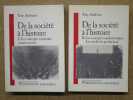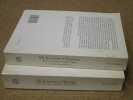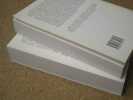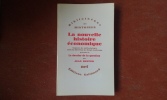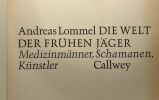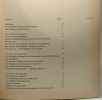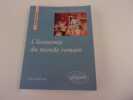-
Type
Any type (2)
Artists book (1)
Autograph (5)
Book (215365)
Disk (1)
Drawings (26)
Engraving (17)
Magazine (1302)
Manuscript (40)
Maps (44)
New book (1)
Old papers (16)
Photographs (66)
Postcards (2)
Posters (12)
-
Latest
Last 24h (7)
Last 3 days (83)
Last month (1669)
Last week (262)
-
Century
15th (1)
16th (255)
17th (1008)
18th (4310)
19th (24434)
20th (88861)
21st (11378)
lrb.search.century.FOURTEEN (1)
-
Countries
Belgium (27194)
Brazil (1)
Canada (502)
China (10)
Côte d'Ivoire (711)
Denmark (2026)
France (169087)
Germany (617)
Greece (68)
Italy (7)
Netherlands (175)
Switzerland (16502)
-
Syndicate
ALAC (498)
CLAM (132)
CLAQ (446)
CNE (28)
ILAB (98406)
NVVA (5678)
SLACES (5503)
SLAM (88861)
SNCAO (27)
GEOGRAPHIE. LES PRINCIPALES PUISSANCES ECONOMIQUES DU MONDE. RESUME AIDE-MEMOIRE. CLASSES DE PHILOSOPHIE ET MATHEMATIQUES.
HATIER. 1942. In-12. Cartonné. Etat d'usage, Couv. légèrement passée, Dos satisfaisant, Intérieur frais. 199 pages.. . . . Classification Dewey : 372.89-Livre scolaire : histoire / géographie
Classification Dewey : 372.89-Livre scolaire : histoire / géographie
Les conduites émotives
Paris, PUF, 1968, Coll. "SUP - initiation philosophique". In-8 (180x115mm) broché, 132 p. Quelques petites marques au crayon de papier (très facilement effaçables). Très bon état général.
De la société à l'histoire : les concepts communs à toute sociétés - les concepts transhistoriques, les modes de production (2 volumes).
Klincksieck Méridiens 1989 Méridiens Klincksieck, Philosophie, 2 volumes, 1989, 751-595 pp, brochés, environ 23x16 cm. De petites traces d'adhésif sur un second plat, coins des plats légèrement cornés, bon état pour le reste et intérieurs bien propres.
Merci de nous contacter à l'avance si vous souhaitez consulter une référence au sein de notre librairie.
Vers l'inconnu, 40 siècles d'exploration.
Paris, France Loisirs, 1990. 24 x 28, 336 pp., très nombreuses illustrations en couleurs, reliure d'édition carton + jaquette, état neuf.
préface par Y. Lacoste.
La nouvelle histoire économique. Exposés de méthodologie sous la direction de Ralph Andreano. Précédé de : "Le Dosssier de la question" par Jean Heffer
Gallimard, 1977, in-8 br., 328 p., coll. "Bibliothèque des Histoires", traduit de l'anglais par Roger Gilles, bon état.
Depuis une quinzaine d'années s'est développée aux États-Unis, à partir de Chicago et spécialement autour des travaux de Robert Fogel et de Stanley Engerman, une véritable école d'économétrie rétrospective. Elle consiste à appliquer des modèles économétriques à des problèmes historiques classiques, pour mesurer, par exemple, l'impact exact de la construction des transcontinentaux ou de l'économie de la plantation esclavagiste sur l'ensemble de l'histoire américaine. Cette «nouvelle histoire économique» a immédiatement suscité de fortes réactions d'enthousiasme ou d'hostilité, tant de la part d'économistes que d'historiens traditionnels. Renouvellement décisif de l'histoire économique pour certains, pour d'autres canular coûteux. Les controverses sur la validité de la méthode, les limites de son utilisation, les possibilités de collaboration entre historiens et économistes, loin d'être apaisées aux États-Unis, n'ont guère eu encore d'écho en France en dehors du cercle des initiés. Malgré son aridité, la discussion pourtant va loin. La traduction des plus importantes parmi les contributions critiques américaines, et leur ample présentation par Jean Heffer, un des meilleurs jeunes spécialistes français, aidera-t-elle à la faire rebondir ici ? C'est le but.
LES POLITIQUE DE L'EGLISE
DU CERF. JANVIER 1999. In-12. Broché. Bon état, Couv. convenable, Dos satisfaisant, Intérieur frais. 197 pages.. . . . Classification Dewey : 270-Histoire et géographie de l'Eglise
Traduit de l'italien par Jacques Mignon. Classification Dewey : 270-Histoire et géographie de l'Eglise
Tractatus contra Graecos
, Brepols, 2020 Hardback, xcv + 248 pages, Size:155 x 245 mm, Illustrations:2 col., Language: Latin. ISBN 9782503588742.
Summary Das 13. Jahrhundert stellt eine zentrale Epoche f r die Geschichte der Beziehungen Ost- und Westkirche dar. Die Eroberung Konstantinopels durch die Kreuzfahrer im Jahr 1204 und die daran anschlie ende Etablierung eines sogenannten Lateinischen Kaiserreichs (1204-1261) gilt heute sowohl in der Forschungslandschaft, als auch in den Erinnerungskulturen der Kirchen als signifikantes Ereignis auf der Bruchlinie zwischen dem lateinischen Westen und dem griechischen Osten. Den gerade erst neu gegr ndeten Mendikantenorden kam vor dem Hintergrund ihres missionarischen Ordensauftrags und wesentlich unterst tzt durch ihre fl chendeckenden Ordensstrukturen eine gewichtige Rolle innerhalb der literarisch-theologischen Kontroverse mit den Byzantinern zu. Als Meilenstein dieser Kontroverse pr sentiert die vorliegende kritische Edition das Dossier eines anonymen, in Konstantinopel t tigen Dominikaners unter dem Titel Tractatus contra Graecos (1252). Dieses Werk, das weite Verbreitung vor allem im Umkreis der (Unions-)Konzilien des 15. Jahrhunderts erfahren hat, stellt auf lateinischer Seite die erste systematische und griechisch-patristisch untermauerte Behandlung jener vier Konfliktpunkte dar, die in dieser Form von nun an standardm ig auf der Agenda der ost-westlichen Debatten standen (Filioque, Azymen, Purgatorium/Eschatologie und Primat Roms). Zudem bietet der Traktat in Form eines Appendix einen reichen Schatz an klassischen und zeitgen ssischen Quellen, die zum Teil singul re berlieferungszeugen sind. Vor diesem Hintergrund ist der Tractatus contra Graecos ein wertvolles Dokument nicht nur f r die Beziehungsgeschichte zwischen stlich und westlich gepr gter Theologie, sondern zudem ein Baustein zur Geschichte und Theologie des Dominikanerordens in der noch jungen Randprovinz "Graecia".
Art du Portrait
, Citadelles & Mazenod, 2002 Livre reli avec jaquette + tui, 416 pages tr s richement illustr avec des illustrations en couleur, 29 x 5 x 35 cm Texte en fran ais, ***tr s bon tat. ISBN 9782850881886.
L'effigie individuelle de l'homme a connu au cours des si cles des destin es fort diverses. Faisant fi des accusations de la th orie artistique, qui lui reprochait de n' tre qu'une simple imitation de la nature, le portrait s'est impos comme une t che capitale de l'art, une t che que tous les grands noms de la peinture - Van Eyck, Clouet, D rer, Rapha l, Holbein, Titien, Hals, Rembrandt, Vel zquez, Goya, Ingres, Manet et, plus pr s de nous, Van Gogh, Picasso ou Warhol - ont lev e ses plus hauts sommets. La s lection de chefs-d'oeuvre op r e ici, pr sent s de mani re chronologique, rend compte de tous les styles d'oeuvres : portraits officiels et d'apparat, portraits intimistes, de groupe ou d'amis, autoportraits et portraits histori s... La succession et la confrontation de ces peintures visent galement aiguiser le regard, afin qu'il reconnaisse les conventions et les inventions perceptibles dans cette volont de saisir la personnalit individuelle du mod le. Repr senter un personnage n'est pas seulement en restituer la physionomie, c'est aussi le mettre en sc ne. La forme m me du portrait appara t comme l'expression loquente d'une conscience de soi propre chaque poque, comme un fil conducteur travers l'histoire de l'art. D charg d'une partie de sa fonction par la photographie, le portrait devient alors distanciation par rapport l'image fid le, pour s'aventurer sur le terrain de la distorsion et de l'abstraction. De l'Antiquit nos jours, plus de deux cents peintures reproduites en pleine page, et sous forme de d tails fortement agrandis, illustrent l'un des genres les plus dynamiques de l'histoire de l'art. Tous les grands tableaux de l'artiste sont ici reproduits, mais galement un nombre important de dessins et de gravures, permettent de comprendre la conception de ses oeuvres et leur diffusion. Son travail d'architecte et de d corateur (Loges, Chambres, villa Madame...)y est galement abord .
Königsmacht und Krongut. Die Machtgrundlage des deutschen Königtums im 13. Jahrhundert und eine neue historische Methode.
1988 / 470 pages. Broché. Editions Steiner
Gure Zustand
Opera IV. Expositio super Ysaiam
, Brepols, 2021 Hardback, lxviii + 355 pages, Size:155 x 245 mm, Language: Latin. ISBN 9782503589831.
Summary Andrew of Saint Victor was one of the most prominent biblical scholars of the twelfth century. He was a regular canon of the Parisian abbey of St Victor, which in the twelfth century had developed into a prestigious center of spiritual learning, closely connected to the nascent university in Paris. Because of his frequent use of Jewish exegetical materials, Andrew's commentaries are a rich source for the history both of biblical hermeneutics and of inter-religious dialogue during the Middle Ages. His Isaiah commentary caused outrage among medieval Christian scholars because it eschewed traditional christological interpretations, and instead offered a reading "secundum Hebraeos." Scholars have seen Andrew of St Victor as standing at the cradle of a scholarly interest in the Biblical text, which influenced scholars such as the fourteenth-century Franciscan Nicholas of Lyra, and, in the long run, reformers such as John Wycliff, Martin Luther, and John Calvin.
A Berlin sous les nazis.
P., Flammarion, 1966, in 8° broché, 299 pages.
PHOTOS sur DEMANDE. ...................... Photos sur demande ..........................


Phone number : 04 77 32 63 69
Pyke Koch de wereld van Pyke Koch
, WBooks, 2017 hardcover 160 pag. met prachtige illustraties. prima staat NL. ISBN 9789462582385.
Pyke Koch neemt een bijzondere plek in binnen de Nederlandse kunstgeschiedenis. Als autodidact ontwikkelde hij zich verbluffend snel en in de jaren dertig was zijn naam definitief gevestigd als een van de meest vooraanstaande kunstenaars in Nederland. In dit boek gaan vier auteurs in op de wereld van Pyke Koch: zijn werk en zijn leven in de context van zijn tijd. Kleinzoon Andreas Koch herinnert zich zijn grootvader als een man met een haarscherpe esthetische blik. Kunsthistoricus Roman Koot gaat in op het vroege werk en beschrijft het culturele wereldje van schrijvers, dichters en schilders waarin Koch zich bewoog. Universitair hoofddocent Mieke Rijnders behandelt Kochs belangstelling voor het fascisme tegen de achtergrond van de algemenen politieke onvrede die in de jaren dertig heerste. Marja Bosma, conservator van het Centraal Museum, exploreert Kochs drijfveren en zijn diepe verlangen naar een ideale kunst.
Andreas Lommel Die Welt der frühen jäger - medizinmänner Schamanen Künstler Callwey
Georg. D.W. Callwey 1965 in4. 1965. Cartonné jaquette. illustrations en noir et blanc et en couleurs
jaquette abîmée déchirée à plusieurs endroits bords frottés livre en bon état général intérieur jauni marges ternies
If Christ Has Not Been Raised ... Studies on the Reception of the Resurrection Stories and the Belief in the Resurrection in the Early Church
, Vandenhoeck & Ruprecht, 2017 Hardcover, 229 pages, text in English. New= fine condition. ISBN 9783525593745.
The present volume contains the proceedings of the fourth symposium of the Novum Testamentum Patristicum project (NTP), an international re-search project on the reception history of the New Testament in the early Church. The symposium was held in October 2012 at the University of Leuven. It was organised by Joseph Verheyden, Tobias Nicklas, and An-dreas Merkt, the coordinators of NTP. The topic of the meeting was the reception of the resurrection and empty tomb stories and the development of the belief in resurrection in the early Church.The belief in the resurrection constitutes the core issue of Christianity and of Christian tradition. The earliest references to the resurrection and witnesses to such a belief are found in the canonical gospels and in the letters of Paul, but the topic obviously remained of the utmost importance all through the early Church. Contributions to this volume offer studies on reception of the resurrection and empty tomb stories and the development of the belief in resurrection in the early Church by examining the most important early references on this topic.
Middle and Late Byzantine Poetry: Texts and Contexts
, Brepols, 2019 Paperback, vii + 413 pages, Size:156 x 234 mm, Illustrations:1 b/w, Language: English. ISBN 9782503578866.
Summary It is only in recent years that Byzantine poetry - a long-neglected aspect of Byzantine literature - has attracted the attention of philologists, literary and cultural historians. This holds true especially for the poetry written in middle and late Byzantium.Though many collections of poems are available in modern critical editions, a considerable amount of texts still remains completely unedited or accessible only in outdated and unreliable editions. Moreover, many works of this period have never been studied thoroughly with regard to their cultural impact on society. Issues of authorship and patronage, function, literary motives, generic qualities, and manuscripts still await further study. This volume aims to take a step to fill this gap. Although it includes studies on poetry from the early tenth to the fifteenth centuries, the main focus is placed on the Komnenian and Palaeologan times. It presents editions of completely unknown texts, such as a twelfth-century cycle of epigrams on John Klimax. It includes studies on various types of poetry, including didactic, occasional, and even poetry written for liturgical purposes. By analysing these works and placing them within their literary and socio-cultural context, we can draw conclusions about the cultural tastes of the Byzantines and acquire a more nuanced picture of middle and late Byzantine poetry. TABLE OF CONTENTS Nikos Zagklas & Andreas Rhoby, Introduction Part I: Studies in the Poetry of the Middle and Late Byzantine Period Section I: Forms, Perceptions & Functions Floris Bernard, Rhythm in the Byzantine Dodecasyllable: Practices and Perceptions Nikos Zagklas, Metrical Polyeideia and Generic Innovation in the Twelfth Century: The Multimetric Cycles of Occasional Poetry Section II: Authors & Texts Maria Tomadaki, The Reception of Ancient Greek Literature in the Iambic Poems of John Geometres Przemys?aw Marciniak & Katia Warcaba, Theodore Prodromos' Katomyomachia as a Byzantine Version of Mock-Heroic Epic Andreas Rhoby, The Poetry of Theodore Balsamon: Form and Function Krystina Kubina, Manuel Philes - A Begging Poet? Requests, Letters and Problems of Genre Definition Marina Bazzani, The Art of Requesting in the Poetry of Manuel Philes Section III: Hymnography & Its Contexts Theodora Antonopoulou, Imperial Hymnography? The Canons Attributed to Emperor Constantine VII Porphyrogenitus. With the critical edition of the First Canon on St John Chrysostom Dimitrios Skrekas, Translations and Paraphrases of Liturgical Poetry in Late Byzantine Thessalonica Part II: The Editio princeps of a Completely Unknown Text Renaat Meesters and Rachele Ricceri, A Twelfth-Century Cycle of Four Poems on John Klimax: Editio princeps, Translation and Commentary Renaat Meesters, A Twelfth-Century Cycle of Four Poems on John Klimax: A Brief Analysis
Lettre ouverte à Freud
Paris, Lieu Commun, 1983. In-8 (220x135mm) broché, XVII - 142 p. Soulignures. Bon état général
HEIDI KIPPENBERG
, Arnoldsche, 2021 Paperback, 96 pages, GER, 240 x 170 mm, NEU, ca 50 ill. in farbe. ISBN 9783897906389.
Heidi Kippenberg studied ceramics under Walter Popp, the legendary teacher at the Kassel Art Academy whose avant-garde work opened up new dimensions of form and expression for ceramic vessels. She internalized the aesthetic of Popp?s vessels and simultaneously gave them her own distinctive touch. Strongly twisted, thick-walled, sometimes mounted stoneware vessels, further enlivened by thick monochrome glazes and augmented with sign-like contrasting glazed accents, characterize her oeuvre. Later she was inspired by East Asian ceramics and began to build her vessels, assembling them from slabs, giving their surfaces a lively structure, and transforming them into decorative landscapes. An oeuvre spanning more than half a century can be admired!
Andr V sale : exp rimentation et enseignement de l'anatomie au XVIe si cle
, Biblioth que Royale Albert Ier 1993, 1993 Softcover, 178 pages, Texte en Francais, 255 x 190 mm, bon etat, ill. de couleur et n/b. ISBN 9782870930793.
Andreas Vesalius: Anatomy and the World of Books
London, Reaktion Books, 2024 Hardcover, 224 pages, 22 x 14.5 cm, Illustrated. *Fine. ISBN 9781789148527.
A revisionist biography of Andreas Vesalius - the father of modern anatomy - as deeply shaped by Renaissance culture. In 1543 the young and ambitious physician Andreas Vesalius published one of the most famous books in the history of medicine, On the Fabric of the Human Body. While we often think of dissection as destroying the body, Vesalius believed that it helped him understand how to construct the human body. In this book, Sachiko Kusukawa shows how Vesalius's publication emerged from the interplay of Renaissance art, printing technology, and classical tradition. She challenges the conventional view of Vesalius as a proto-modern, anti-authoritarian father of anatomy through a more nuanced account of how Vesalius exploited cultural and technological developments to create a big and beautiful book that propelled him into imperial circles and secured his enduring fame.'Kusukawa's vivid reconstruction of the making of Vesalius's Fabrica takes us deep inside the world of anatomical demonstrations, hospital postmortems, criminal executions, university lecture halls, humanist libraries and artistic and printing workshops. She explains how Vesalius thought about books, images and bodies, and his skill at instructing Renaissance readers how to look, touch, dissect and model the human body in order to learn from it. There is no better introduction to Vesalius.' - Paula Findlen, Stanford University'In this brilliant digestion of her earlier work, Kusukawa not only reconstructs 'the making' of Andreas Vesalius's masterpiece, Fabrica (and the book's reception and afterlife), but the making of the man himself. The 'founder' of modern anatomy we see in full context, reliant on his peers, his readers and his students in the production of his masterpiece. He is also shown to be a canny negotiator with artists and printers in the making of the book's famous images. Ultimately Andreas Vesalius: Anatomy and the World of Books compels engagement with the construction of the 'truthfulness' of all scientific images, then and now. This is historical anatomy and provocation at its arresting best.' - Claudia Stein, University of Warwick
Osmanli-Iran-Rus Iliskilerine ait iki kaynak, I: Petros di Sarkis Gilanentz'in Kronolojisi, II: Nadir Sah Devrine ait bir Anonim Kronoloji
Istanbul, Edebiyat Fakultesi Matbaasi 1974 vii + 116pp., original 1974-edition, 24cm., softcover, text in Turkish, in the series "Istanbul Universiteti Edebiyat Fakultesi Yayainlari" no.1900, good condition, X114344
Urfali Mateos Vekayi-Namesi (952-1136) ve Papaz Grigor'un Zeyli (1136-1162)
Ankara, Turk Tarih Kurumu Basimevi 1962 xxv + 411pp., text in Turkish, original 1962-edition, in the series "Türk Tarih Kurumu Yayinlarindan" II.Series no.21, bound in hardcover, spine in blue leather with gilt title, good condition, weight: 1kg., X114340
La vie financière dans le monde romain. Les métiers de manieurs d'argent (IVe siècle av. J.-C.- IIIe siècle ap; J.-C.).
Rome, E. F. R., 1987 Fort in-8, cartonnage ill. d'édition, 790 pp., bibliographie, index rerum et nominum, index des sources antiques.
Très bonne cond. - Frais de port : -France 6,9 € -U.E. 11 € -Monde (z B : 18 €) (z C : 31 €)
L'ECONOMIE DU MONDE ROMAIN
Format moyen, couverture souple. 281 pages. Très bon état 2018 ellipses
LA PRISE DE COMBLES
Paris, Rouff 1917. In Paris, Rouff 1917. In-8 agrafé de 24 pages. Couverture illustrée. Collection Patrie N° 18.
Bon état Toutes les expéditions sont faites en suivi au-dessus de 25 euros. Expédition quotidienne pour les envois simples, suivis, recommandés ou Colissimo.
AMOURS ET LARMES (Chronique d'une famille franc-Comtoise les Le Boeuf de Valdahon 1555-1941)
1521 Broché - 15 x 21 - 228 pp - année 1996 - imprimer sur les presses de Caracter's Besançon - illustrations
 Write to the booksellers
Write to the booksellers
